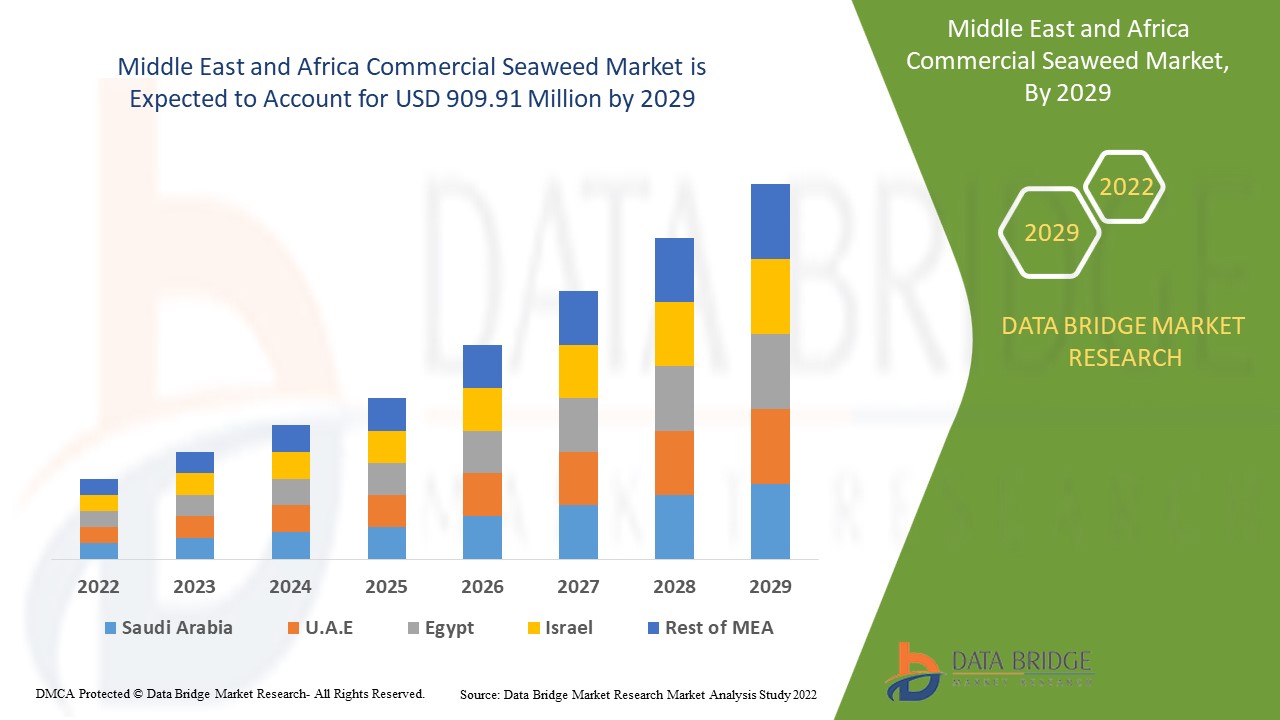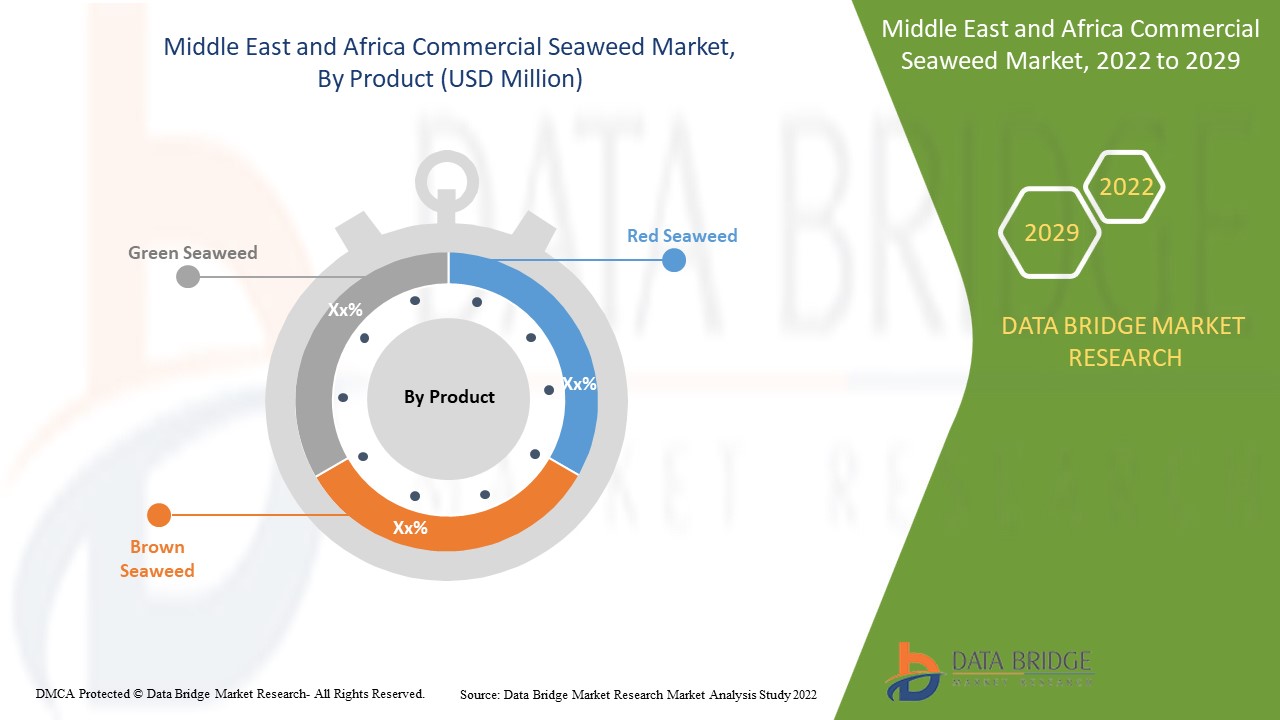Middle East and Africa Commercial Seaweed Market, By Product (Red Seaweed, Brown Seaweed, Green Seaweed), Form (Liquid, Powdered, Flakes), Cultivation (Onshore Cultivation, Offshore Cultivation, Nearshore Cultivation, IMTA Cultivation, Saline Aquaculture), End-User (Food & Beverages, Pharmaceuticals, Agriculture, Animal Feed, Cosmetics & Personal Care, Biofuels, and Others), Country (South Africa, U.A.E., Kuwait, Saudi Arabia and Rest of the Middle East and Africa) Industry Trends and Forecast to 2029

Market Analysis and Insights: Middle East and Africa Commercial Seaweed Market

The Middle East and Africa commercial seaweed market is expected to gain market growth in the forecast period of 2022 to 2029. Data Bridge Market Research analyses that the market is growing with a CAGR of 5.4% in the forecast period of 2022 to 2029 and is expected to reach USD 909.91 million by 2029. Increasing adoption of seaweed for hydrocolloids may drive the Middle East and Africa commercial seaweed market.
Commercial seaweed is the microalgae that grow in the sea, irrespective of marine water or freshwater. They are the food source for life in the ocean and can be found in three colors red seaweed, green seaweed, and brown seaweed based on the pigments present. Seaweeds grow mostly along the rocky shorelines all around the world. Commercial seaweed is an enriched source of proteins, vitamins, minerals, fibers, iodine, and antioxidants. Additionally, commercial seaweed is known to provide health benefits such as decreasing the risk of heart disease, diabetes, and goiter and improving gut health.
The Middle East and Africa commercial seaweed market may propel tremendously in this region as commercial seaweeds are majorly famous for the hydrocolloids and have a wide application in various industries such as food & beverages, agriculture, animal feed, cosmetics & personal care, and pharmaceuticals. However, the environmental risk associated with the seaweed and the high amount of iodine and heavy metals present is expected to restrain the market growth. Emerging applications of seaweed in various industries may create opportunities in the market, and high seaweed prices may challenge market growth.
The Middle East and Africa commercial seaweed market report provide details of market share, new developments, and product pipeline analysis, the impact of domestic and localized market players, analyses opportunities in terms of emerging revenue pockets, changes in market regulations, product approvals, strategic decisions, product launches, geographic expansions, and technological innovations in the market. To understand the analysis and the Middle East and Africa commercial seaweed market scenario, contact Data Bridge Market Research for an Analyst Brief; our team will help you create a revenue impact solution to achieve your desired goal.

Middle East and Africa Commercial Seaweed Market Scope and Market Size

The Middle East and Africa commercial seaweed market is segmented into four notable segments based on product, form, cultivation, and end-user. The growth among segments helps you analyze niche pockets of growth and strategies to approach the market and determine your core application areas and the difference in your target markets.
- On the basis of product, the Middle East and Africa commercial seaweed market is segmented into red seaweed, green seaweed, and brown seaweed. In 2022, the red seaweed segment is expected to dominate the market due to increased awareness about the health benefits of red seaweed and a rise in demand for more natural and organic products.
- On the basis of form, the Middle East and Africa commercial seaweed market is segmented into liquid, powdered, and flakes. In 2022, the powdered segment is expected to dominate the market due to growing applications of the powder form of seaweed in food and beverages.
- On the basis of cultivation, the Middle East and Africa commercial seaweed market is segmented into onshore cultivation, offshore cultivation, nearshore cultivation, IMTA cultivation, and saline aquaculture. In 2022, the offshore segment is expected to dominate the commercial seaweed market due to the huge production of seaweed through the offshore method.
- On the basis of end-user, the Middle East and Africa commercial seaweed market is segmented into food & beverages, pharmaceuticals, agriculture, animal feed, cosmetics & personal care, biofuels, and others. In 2022, the food & beverages segment is expected to dominate the commercial seaweed market due to increased awareness about the nutrient enrichment and health benefits offered by the seaweed and a rise in demand for more natural and organic food and beverages products.
Middle East and Africa Commercial Seaweed Market Country Level Analysis
The Middle East and Africa commercial seaweed market is analyzed, and market size information is provided by country, product, form, cultivation, end-user.
The countries covered in the Middle East and Africa commercial seaweed market are France, the U.K., Germany, Italy, Switzerland, Denmark, Norway, Russia, Spain, Netherlands, Belgium, and the Rest of Europe.
The red seaweed segment in South Africa is expected to grow with the highest growth rate in the forecast period because of the growing consumption and production of food applications that utilize commercial seaweed. The red seaweed segment in Kuwait is expected to grow significantly due to the rise in seaweed farming practices with the growing demand. U.A.E. is projected to be the fastest-growing country of the Middle East and Africa market. The red seaweed segment is expected to dominate in this country due to the high nutritional value and health benefits of seaweed that aid in combating various diseases.
The country section of the report also provides individual market impacting factors and changes in regulation in the market domestically that impact the current and future trends of the market. Data points such as new sales, replacement sales, country demographics, regulatory acts, and import-export tariffs are some of the major pointers used to forecast the market scenario for individual countries. Also, the presence and availability of the Middle East and African brands and their challenges faced due to large or scarce competition from local and domestic brands, the impact of sales channels are considered while providing forecast analysis of the country data.
Growing Strategic Activities by Major Market Players to Enhance the Awareness for Commercial Seaweed is Boosting the Market Growth
The Middle East and Africa commercial seaweed market also provides you with detailed market analysis for every country's growth in the particular market. Additionally, it provides detailed information regarding the market players’ strategy and their geographical presence. The data is available for the historical period 2011 to 2019.
Competitive Landscape and Middle East and Africa Commercial Seaweed Market Share Analysis
The Middle East and Africa commercial seaweed market competitive landscape provide details by the competitor. Details included are company overview, company financials, revenue generated, market potential, investment in research and development, new market initiatives, production sites and facilities, company strengths and weaknesses, product launch, product trials pipelines, product approvals, patents, product width, and breadth, application dominance, technology lifeline curve. The above data points provided are only related to the company’s focus related to the Middle East and Africa commercial seaweed market.
Some major companies dealing in the Middle East and Africa commercial seaweed market are Cargill, Incorporated, Kai Ho "Oceans Treasure," Raw Seaweeds, ALGOLESKO, AtSeaNova, BY VIET DELTA, Aushadh Limited., Shore Seaweed, among other domestic players. DBMR analysts understand competitive strengths and provide competitive analysis for each competitor separately.
Many contracts and agreements are also initiated by the companies worldwide, accelerating the Middle East and Africa commercial seaweed market.
For instance,
- In October 2020, ALGOLESKO obtained fundraising of USD 1.35 million via the company GwenneG. This fundraising has helped the company in research and development activities
Collaboration, product launch, business expansion, award and recognition, joint ventures, and other strategies by the market player enhance the company's footprints in the Middle East and Africa commercial seaweed market, which also benefits the organization’s profit growth.
SKU-

